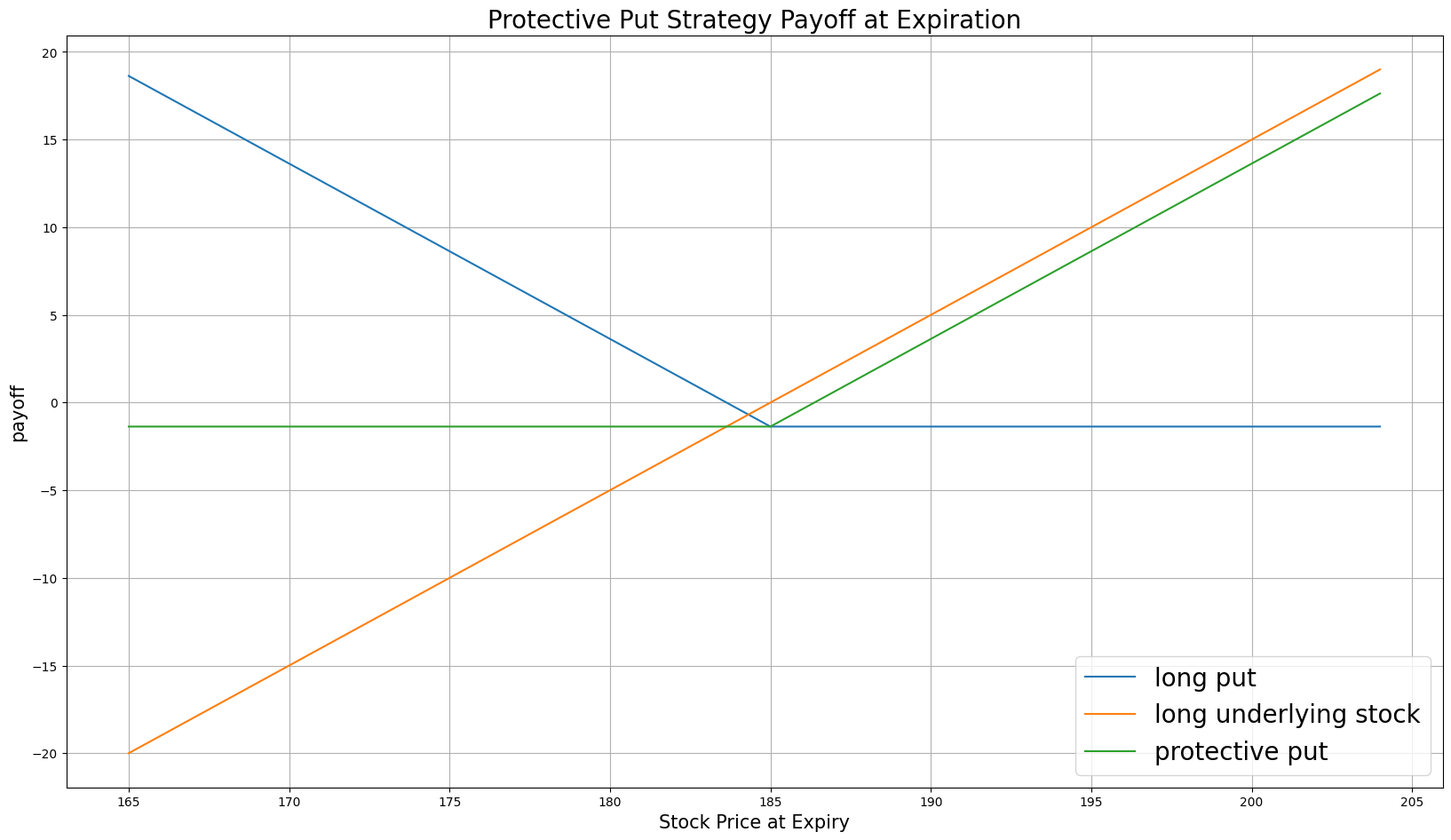Option Strategies
Protective Put
Introduction
A Protective Put consists of buying a long position in a stock and a long position in put Options for the same amount of stock. Protective puts aim to hedge the long position of a stock with a long ATM or slightly OTM put Option. At any time for American Options or at expiration for European Options, if the stock moves above the strike price, the Option contract becomes worthless but the long stock position acquires an unrealized gain. If the underlying price moves below the strike, you can exercise the Options contract, which sells your underlying position at the put Option strike price.
Implementation
Follow these steps to implement the protective put strategy:
- In the
Initializeinitializemethod, set the start date, end date, starting cash, and Options universe. - In the
OnDataon_datamethod, select the Option contract. - In the
OnDataon_datamethod, place the orders.
private Symbol _symbol;
public override void Initialize()
{
SetStartDate(2024, 9, 1);
SetEndDate(2024, 12, 31);
SetCash(100000);
UniverseSettings.Asynchronous = true;
var option = AddOption("IBM");
_symbol = option.Symbol;
option.SetFilter(universe => universe.IncludeWeeklys().NakedPut(30, 0));
} def initialize(self) -> None:
self.set_start_date(2024, 9, 1)
self.set_end_date(2024, 12, 31)
self.set_cash(100000)
self.universe_settings.asynchronous = True
option = self.add_option("IBM")
self._symbol = option.symbol
option.set_filter(lambda universe: universe.include_weeklys().naked_put(30, 0))
The NakedPutnaked_put filter narrows the universe down to just the one contract you need to form a protective put.
public override void OnData(Slice slice)
{
if (Portfolio.Invested ||
!slice.OptionChains.TryGetValue(_symbol, out var chain))
{
return;
}
// Find ATM put with the farthest expiry
var expiry = chain.Max(x => x.Expiry);
var atmPut = chain
.Where(x => x.Right == OptionRight.Put && x.Expiry == expiry)
.OrderBy(x => Math.Abs(x.Strike - chain.Underlying.Price))
.FirstOrDefault(); def on_data(self, slice: Slice) -> None:
if self.portfolio.invested:
return
chain = slice.option_chains.get(self._symbol)
if not chain:
return
# Find ATM put with the farthest expiry
expiry = max([x.expiry for x in chain])
put_contracts = sorted([x for x in chain
if x.right == OptionRight.PUT and x.expiry == expiry],
key=lambda x: abs(chain.underlying.price - x.strike))
if not put_contracts:
return
atm_put = put_contracts[0]
Approach A: Call the OptionStrategies.ProtectivePutOptionStrategies.protective_put method with the details of each leg and then pass the result to the Buybuy method.
var protectivePut = OptionStrategies.ProtectivePut(_symbol, atmPut.Strike, expiry); Buy(protectivePut, 1);
protective_put = OptionStrategies.protective_put(self._symbol, atm_put.strike, expiry) self.buy(protective_put, 1)
Approach B: Create a list of Leg objects and then call the Combo Market Ordercombo_market_order, Combo Limit Ordercombo_limit_order, or Combo Leg Limit Ordercombo_leg_limit_order method.
var legs = new List<Leg>()
{
Leg.Create(atmPut.Symbol, 1),
Leg.Create(chain.Underlying.Symbol, chain.Underlying.SymbolProperties.ContractMultiplier)
};
ComboMarketOrder(legs, 1); legs = [
Leg.create(atm_put.symbol, 1),
Leg.create(chain.underlying.symbol, chain.underlying.symbol_properties.contract_multiplier)
]
self.combo_market_order(legs, 1)
Strategy Payoff
The payoff of the strategy is
$$ \begin{array}{rcll} P^{K}_T & = & (K - S_T)^{+}\\ P_T & = & (S_T - S_0 + P^{K}_T - P^{K}_0)\times m - fee \end{array} $$ $$ \begin{array}{rcll} \textrm{where} & P^{K}_T & = & \textrm{Put value at time T}\\ & S_T & = & \textrm{Underlying asset price at time T}\\ & K & = & \textrm{Put strike price}\\ & P_T & = & \textrm{Payout total at time T}\\ & S_0 & = & \textrm{Underlying asset price when the trade opened}\\ & P^{K}_0 & = & \textrm{Put price when the trade opened (credit received)}\\ & m & = & \textrm{Contract multiplier}\\ & T & = & \textrm{Time of expiration} \end{array} $$The following chart shows the payoff at expiration:

The maximum profit is $S_T - S_0 - P^{K}_0$, which occurs when the underlying price is above the $S_0 + P^{K}_0$.
The maximum loss is $P^{K}_0$, which occurs when the underlying price drops.
Example
The following table shows the price details of the assets in the algorithm:
| Asset | Price ($) | Strike ($) |
|---|---|---|
| Put | 1.53 | 185.00 |
| Underlying Equity at start of the trade | 187.07 | - |
| Underlying Equity at expiration | 190.01 | - |
Therefore, the payoff is
$$ \begin{array}{rcll} P^{K}_T & = & (K - S_T)^{+}\\ & = & (185 - 190.1)^{+}\\ & = & 0\\ P_T & = & (S_T - S_0 + P^{K}_T - P^{K}_0)\times m - fee\\ & = & (190.01 - 187.07 + 0 - 1.53)\times m - fee\\ & = & 1.41 \times 100 - 2\\ & = & 139 \end{array} $$So, the strategy gains $139.
The following algorithm implements a protective put Option strategy:
public class ProtectivePutAlgorithm : QCAlgorithm
{
private Symbol _put, _symbol;
public override void Initialize()
{
SetStartDate(2024, 9, 1);
SetEndDate(2024, 12, 31);
SetCash(100000);
var option = AddOption("IBM");
_symbol = option.Symbol;
option.SetFilter(universe => universe.IncludeWeeklys().NakedPut(30, 0));
// use the underlying equity as the benchmark
SetBenchmark(_symbol.Underlying);
}
public override void OnData(Slice slice)
{
if (_put != null && Portfolio[_put].Invested) return;
if (!slice.OptionChains.TryGetValue(_symbol, out var chain)) return;
// Find ATM put with the farthest expiry
var expiry = chain.Max(x => x.Expiry);
var atmPut = chain
.Where(x=> x.Right == OptionRight.Put && x.Expiry == expiry)
.OrderBy(x => Math.Abs(x.Strike - chain.Underlying.Price))
.FirstOrDefault();
if (atmPut == null) return;
var protectivePut = OptionStrategies.ProtectivePut(_symbol, atmPut.Strike, expiry);
Buy(protectivePut, 1);
_put = atmPut.Symbol;
}
} class ProtectivePutAlgorithm(QCAlgorithm):
def initialize(self) -> None:
self.set_start_date(2024, 9, 1)
self.set_end_date(2024, 12, 31)
self.set_cash(100000)
option = self.add_option("IBM")
self.symbol = option.symbol
option.set_filter(lambda universe: universe.include_weeklys().naked_put(30, 0))
self.put = None
# use the underlying equity as the benchmark
self.set_benchmark(self.symbol.underlying)
def on_data(self, slice: Slice) -> None:
if self.put and self.portfolio[self.put].invested:
return
chain = slice.option_chains.get(self.symbol)
if not chain:
return
# Find ATM put with the farthest expiry
expiry = max([x.expiry for x in chain])
put_contracts = sorted([x for x in chain
if x.right == OptionRight.Put and x.expiry == expiry],
key=lambda x: abs(chain.underlying.price - x.strike))
if not put_contracts:
return
atm_put = put_contracts[0]
protective_put = OptionStrategies.protective_put(self.symbol, atm_put.strike, expiry)
self.buy(protective_put, 1)
self.put = atm_put.symbol